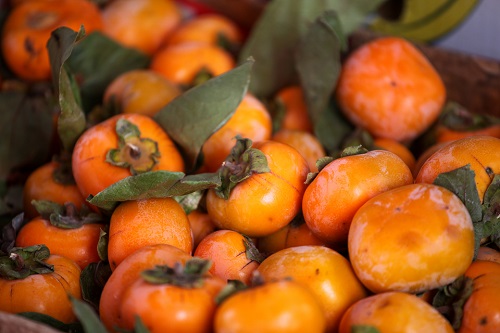Food Facts Friday: Persimmons

It looks like a tomato, but tastes sweet. This orange-red fruit is a persimmon. It has a honey-like flavor with the texture of an apricot. Persimmons are a fall fruit in season October through February, and they’re packed with nutrients!
Persimmon Nutrients
One Japanese persimmon (168 grams) contains:
- Calories: 118
- Carbohydrates: 31 g
- Protein: 1 g
- Fat: 0.3 g
- Fiber: 6 g
- Potassium: 270 mg
- Phosphorus: 28 mg
One American persimmon (25 grams) contains:
- Calories: 32
- Carbohydrates: 8 g
- Protein: 0 g
- Fat: 0 g
- Fiber: 0.2 g
- Potassium: 78 mg
- Phosphorus: 7 mg
Japanese persimmons are high in fiber, which is important for regular bowel movements. Foods high in fiber can also aid in improving cholesterol levels by helping the body excrete it when there is too much. Improving cholesterol levels can improve heart health as well. In addition to fiber, persimmons are high in flavonoids, which are antioxidants that have been associated with lower rates of heart disease.
Persimmons are a good source of thiamin (vitamin B1), riboflavin (vitamin B2) and folate. These are three of the nutrients commonly found in renal multivitamins, as they are lost during the dialysis process.
As a high-potassium fruit, Japanese persimmons may not be a good choice to eat regularly if you are limiting your potassium intake. Talk with your dietitian about what is best for you. However, since American persimmons are much smaller, they are much lower in potassium. Eating one American persimmon can easily be incorporated into a kidney-friendly diet.
Persimmons are also naturally low in phosphorus and fat.
Ways to Eat Persimmons
Unripe persimmons have a bitter taste. So, it’s best to wait to eat until it feels soft to the touch, or when the leafy green top pulls off easily.
Here are some different ways to try persimmons:
- Sliced on salads
- Baked into muffins or breads
- Added to oatmeal
- Used in place of apples in pork dishes
- On their own
Fun Fact
According to American tradition, the pattern inside persimmon seeds can be used to predict the weather. If the shape inside looks like a fork, then the winter will be mild. If it looks like a spoon, then the winter will bring more snow. Lastly, if it resembles a knife, then the harsh cold weather will “cut like a knife.”
Curious about persimmons? Talk to your dietitian to learn more about how to incorporate this sweet fruit into your diet.
References:
- Health Benefits of Persimmons. WebMD. Reviewed by Dan Brennan, MD on November 7, 2020. Accessed on June 2, 2021. https://www.webmd.com/diet/health-benefits-persimmon#1.
- Top 7 Health and Nutrition Benefits of Persimmon. Jillian Kubala. Healthline. Published on May 5, 2018. Accessed on June 2, 2021. https://www.healthline.com/nutrition/persimmon-nutrition-benefits#:~:text=Top%207%20Health%20and%20Nutrition%20Benefits%20of%20Persimmon,6%20Support%20Healthy%20Vision.%20…%20More%20items…%20.
- What Is a Persimmon and What Does It Taste Like? Corey Williams. My Recipes. Updated on September 24, 2019. Accessed on June 2, 2021. https://www.myrecipes.com/how-to/cooking-questions/what-is-persimmon.
Additional Kidney Diet Resources
Visit DaVita.com and explore these diet and nutrition resources:
- DaVita Food Analyzer
- DaVita Dining Out Guides
- Today’s Kidney Diet Cookbooks
- DaVita Kidney-Friendly Recipes
- Diet and Nutrition Articles
- Diet and Nutrition Videos
- Kidney Smart® Virtual Classes
This article is for informational purposes only and is not a substitute for medical advice or treatment. Consult your physician and dietitian regarding your specific diagnosis, treatment, diet and health questions.

Recent Comments